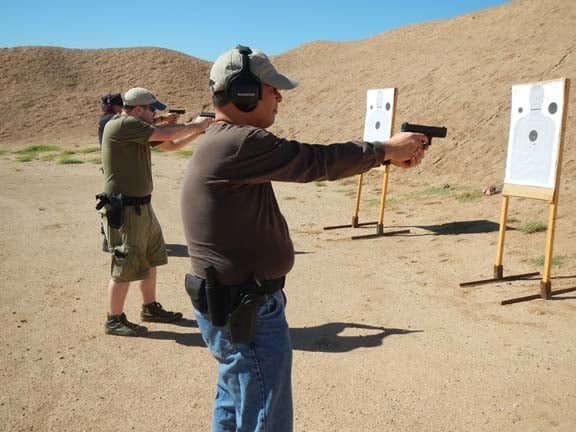P320 Contest: The Argument Against SA/DA Pistols
By Russel Phagan
I teach armed guard and CCW Classes in Arizona. The students I teach have very diverse backgrounds; some just bought a gun for the first time, some have done multiple deployments in the military, some were police officers for 30 years, some have been shooting their entire lives. The armed guard class is 16 hours total with four hours of range time (there is a lot of legal curriculum mandated by the state). There's no longer a state-mandated curriculum for CCW in Arizona, but I teach four hours in the classroom and four hours on the range as I feel this is the bare minimum necessary for a novice to be able to carry a gun safely and not get themselves in legal trouble . . .
I run the same AZ POST derived qualification course for both classes. It is mandated by the state for armed guards, and it is more than the minimum required for CCW. The armed guards come back annually to re-qualify as required by law. I will usually never see the CCW holders in training again. CCW holders renew their permits every five years by paying a fee again; there is no longer a training renewal requirement.
People who take armed self-defense seriously should continually seek out more and higher levels of training. Unfortunately many people do not practice after taking training or seek out higher levels of training. Understandably budgets are limited, ammo is more expensive year after year, and time is limited. I take my duty as an instructor seriously. I am teaching these students potentially life-saving skills. I often question how I can help my students get the most out of four hours on the range; if they only shoot 100-200 rounds a year or never take any more training? The easiest and most efficient answer seems to be convincing them to use guns/equipment that will maximize the efficiency of minimal training time.
Double action/single action pistols consistently demonstrate a high learning curve in my classes. The students most proficient with DA/SA pistols are former military personnel who carried M9s, or former law enforcement that carried SIGs. In either case they have years of experience using these platforms and have trained to the point of getting accustomed to the trigger and controls. For everyone else, it’s a lot to get used to in four hours.
I start each range session with a half hour of dry fire. During dry fire, I work on trigger control and grip techniques with the students. Double action mode is emphasized with students who have DA/SA guns. I have the students do 50 rounds of live fire starting at three yards, backing up to 15. The qualification is 50 rounds on a TQ-15 target and starts at 15 yards then eventually ends at three. Roughly 1/3 of the qualification shots should be fired on double action mode as that is the way it should be carried in the holster. More often than not the first round on Double Action is low and the second and/or third shots are closer to center of mass. During qualification, some people get stressed, and their fundamentals start to degrade. Pulling rounds completely off the target at 15 and 10 yards is not uncommon.
The second issue with students using DA/SA pistols is getting them to decock to make the gun safe to reholster between each string. Of all the DA/SA guns, SIGs are the easiest to use because the decocker has a single function and it is easily accessed by the thumb of the right hand. Decockers that also function as safeties introduce another level of complexity; the student must remember to decock then turn the safety back off. I remind students to turn off the safety until they have it down. During the stress of the qualification, forgetting to turn the safety back off is a common occurrence and they may fail to get all the rounds off in the time allotted.
Manufacturers, distributors, and retailers all too often approach manual safety devices as a selling point. They assume their customers will not seek training and a manual safety device will help prevent them from having a negligent discharge. Teaching people to use firearms has given me exactly the opposite opinion.
Using a mechanical device as a substitute for following basic gun safety rules is a mistake. I can easily condition people to keep their finger off of the trigger until they are ready to shoot. It's much harder to train them to consistently actuate a mechanical safety, particularly one that also functions as a de-cocker. If people have a hard time using these controls under the mild stress of a square range qualification, it will be significantly worse if they're in a fight for their lives. I view manual safety devices as a liability on a defensive pistol, tools that someone must be able to use as quickly as possible with as little conscious thought as possible.
Striker fired pistols like GLOCKSs, M&Ps, XDs, and now the SIG 320 are significantly easier to train a number of shooters of varying skill on in an institutional setting with fewer rounds fired. The trigger pull being the same for every shot with less take-up simplifies trigger control. They don't need to worry about two different pull weights. The lack of a de-cocker and/or safety is one less thing for the shooter to worry about. The student’s mind is freed to think about grip, stance, sight alignment and trigger control. With a single trigger pull weight and no manual safety, there's only one state of readiness that the pistol can be carried in. Consistency is critical in maximizing training value in limited time frames with limited ammunition.
I recently had a student who was using a Beretta PX4 Storm. The student had the right mindset and was eager to learn. The PX4 is not a badly-made or unreliable pistol, but it does have a long double action trigger pull, and a de-cocker/safety. This particular student had limited experience with semi-auto pistols. It became apparent during training that he likely would not qualify; too many of his shots were going low into the unscored zone or off the paper at further distances.
I handed him my GLOCK 17 and let him try it at the same distances. Immediately his group size decreased to 1/3 of what it was before, and all the shots were closer to center of mass. He easily qualified using the GLOCK simply because the trigger pull was the same for every shot. With the right amount of practice he could shoot his PX4 just as well. However, why should one spend more time and money and work harder to accomplish the same result as a platform that requires less time in training and money invested in ammo?
Not every student shows such a remarkable difference in performance when using a striker fired design, but some improvement is immediately apparent and they always get all their rounds off during qualification. Class after class, these things remain consistent; double action pistols and manual safeties/de-cockers force students to work harder to do the same things other students accomplish with less effort using striker-fired designs. If someone knows their training budget and time are limited, I strongly encourage them to pick a platform that will set them up for success by reducing the learning curve through consistent trigger pull and simplified controls.
Russell Phagan is assistant director of training and competition at Route 66 Tactical



